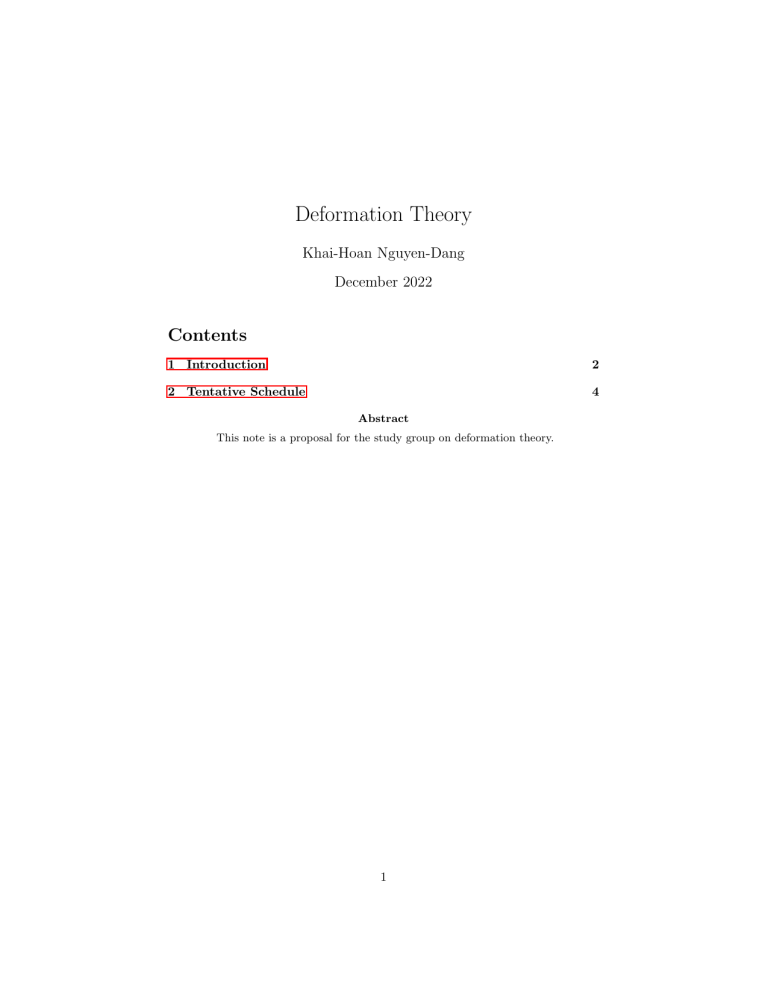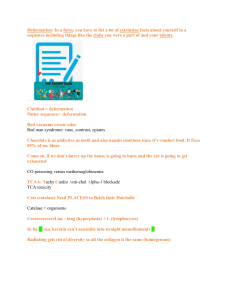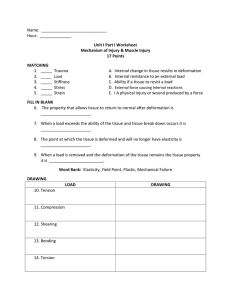
Deformation Theory Khai-Hoan Nguyen-Dang December 2022 Contents 1 Introduction 2 2 Tentative Schedule 4 Abstract This note is a proposal for the study group on deformation theory. 1 1 Introduction Deformation theory is a study of the way algebraic structures vary locally, i.e concerning families of objects X (which can be simply schemes, or complicated structures, like sheaves, bundles, etc) over a scheme S, restricting to a given object X0 over some point s0 ∈ S. X0 X s0 S For example, let A be a local Artin ring and k be its residue field. Suppose that X is a parameter space (e.g moduli space), then the maps Spec A → X correspond to families of objects over Spec A. If we fix a map s0 : Spec k → A and restrict our attention to A with residue field k, we can consider elements of the family restricting to k under the natural map Spec k → Spec A, and this corresponds to studying families of objects over Spec A which restrict to the fixed object Spec k the reduced point; such families are called (infinitesimal) deformations of s0 over Spec A. In other words, deformation theory provides a method that one can go from positive characteristic to characteristic 0. Initially, Kodaira and Spencer laid a foundational study of the deformation of complex varieties in the 50s. Their results connected deformation theory with cohomological algebra. After that, Grothendieck and his school generalized these ideas to scheme theory in 60s. His approach to this problem was to formalize the method of Kodaira and Spencer via formal schemes, which consist of a formal construction followed by a proof of convergence. X0 Xn Spec(k) Spec(A/mn ) From there, deformation theory has been developed and played big roles in many aspects of mathematics such as Deligne proof on Hodge to absolute Hodge for abelian varieties, Serre-Tate for ordinary abelian varieties, Mori’s bend and break techniques, Deformation of Galois representations,... The main references for classical deformation in algebraic geometry are books by Hartshorne [Har10] and Sernesi [Ser06]. One vein of our seminar is to study deformation of Galois representations. Mazur’s theory gives one a universal deformation ring which can be considered a parameter space for all lifts of a given residual representation (up to conjugation). More precisely, given a continuous 22-dimensional mod pp-representation ρ : GQ,S → GL2 (Fp ) where GQ,S is the Galois group of the maximal algebraic extension of Q unramified outside the finite set S of primes of Q, if ρ is absolutely irreducible there 2 is a complete Noetherian local ring R with residue field Fp and a continuous homomorphism ρ : GQ,S → GL2 (R) which is universal in the natural sense. The ring depends on the residual representation and on supplementary conditions one imposes on the lifts. If the residual representation is modular and if the deformation conditions are such that the p-adic lifts satisfy needs that hold for modular Galois representations, then one expects in many cases that the natural homomorphism R → T from the universal ring R to a suitably defined Hecke algebra T is an isomorphism. The proof of such isomorphisms called R = T theorems or modularity theorems is at the heart of the proof of Fermat’s Last Theorem. It expresses that all p-adic Galois representations of the type described by R are modular and in particular that they arise from geometry. We will follow lecture notes by [Gou01]. Mazur’s original paper [Maz89] is the main reference. For more explanation and motivation, look at his introductory paper [Maz97]. Another part of the seminar is to investigate the application of deformation to abelian schemes. Remarkably, the Serre-Tate theorem tells us that deformations of abelian varieties are basically deformations of its pp-divisible groups. One of the main points in Serre–Tate theory is the statement that, if AA is ordinary, its formal deformation space has a canonical structure of a formal torus over the ring of Witt vectors W (k). In particular, this gives rise to a canonical lifting over W (k), corresponding to the identity section of the formal group. The theorem provides us coordinates of local deformations in terms of Tate modules. To conclude the big picture, the theory of Grothendieck-Messing will reduce deformations of pp-divisible groups to some linear algebra via the theory of crystals. We use Shatz’s exposition paper [Sha86] for the first three talks and also look at Tate’s papers [Tat67], [Tat97]. For formal schemes, a good source is Illusie’s paper [Ill05]. The main reference for Serre-Tate theory is Katz’s exposition paper [Kat81] and Chai-Oort’s lecture notes [CO09]. Other materials will be discussed and added during the seminar. 3 2 Tentative Schedule PART I: Galois Theory Talk I • Galois Representations: Galois groups of infinite algebraic extension. Galois group of Q and their representations, give some examples. Speaker: Talk II • Deformation of Representations: Introduction to Witt vectors. Deformation functor and universal deformation. Speaker: Talk III • Cohomological Interpretation: Representable funtor, fiber product and tangent space. Speaker: Talk IV • Universal Deformation Ring: Schlessinger’s criteria and the existence of universal deformation rings. Speaker: Talk V • Universal Deformation Ring: Functorial, cohomological properties. Obstructed and unobstructed problems. Speaker: Talk VI • Explicit Deformations: Give some computation, and focus on tame cases. Speaker: 4 PART II: Algebraic Geometry Talk I • Finite Flat Group Schemes: Introduction to finite group schemes with examples, highlight on N -torsion points of abelian varieties. Their basic properties and the connected-étale sequence. Speaker: Talk II • p-divisible Groups: Introduction to p-divisible group, examples, their basic properties and the connected-étale sequence. Tate module of p-divisible groups and their properties. Speaker: Talk III • Formal Schemes: Give definition, examples and basic properties, especially in the affine case. Formal completion. Formal groups. Speaker: Talk IV • Fppf Sheaf: View these objects above as fppf sheaves. Cartier duality. Speaker: Talk V • Drinfeld’s Rigidity Lemma: Present lemma 1.1.3 in Katz’s paper. Speaker: Talk VI • Serre-Tate Deformation Theorem and Local Coordinates: Theorem 1.2.1 and theorem 2.1 in Katz’s paper Speaker: 5 References [CO09] Ching-Li Chai and Frans Oort. Moduli of abelian varieties and pdivisible groups. In Arithmetic geometry, volume 8 of Clay Math. Proc., pages 441–536. Amer. Math. Soc., Providence, RI, 2009. [Gou01] Fernando Q. Gouvêa. Deformations of Galois representations. In Arithmetic algebraic geometry (Park City, UT, 1999), volume 9 of IAS/Park City Math. Ser., pages 233–406. Amer. Math. Soc., Providence, RI, 2001. Appendix 1 by Mark Dickinson, Appendix 2 by Tom Weston and Appendix 3 by Matthew Emerton. [Har10] Robin Hartshorne. Deformation theory, volume 257 of Graduate Texts in Mathematics. Springer, New York, 2010. [Ill05] Luc Illusie. Grothendieck’s existence theorem in formal geometry. In Fundamental algebraic geometry, volume 123 of Math. Surveys Monogr., pages 179–233. Amer. Math. Soc., Providence, RI, 2005. With a letter (in French) of Jean-Pierre Serre. [Kat81] N. Katz. Serre-Tate local moduli. In Algebraic surfaces (Orsay, 1976– 78), volume 868 of Lecture Notes in Math., pages 138–202. Springer, Berlin-New York, 1981. [Maz89] B. Mazur. Deforming Galois representations. In Galois groups over Q (Berkeley, CA, 1987), volume 16 of Math. Sci. Res. Inst. Publ., pages 385–437. Springer, New York, 1989. [Maz97] Barry Mazur. An introduction to the deformation theory of Galois representations. In Modular forms and Fermat’s last theorem (Boston, MA, 1995), pages 243–311. Springer, New York, 1997. [Ser06] Edoardo Sernesi. Deformations of algebraic schemes, volume 334 of Grundlehren der mathematischen Wissenschaften [Fundamental Principles of Mathematical Sciences]. Springer-Verlag, Berlin, 2006. [Sha86] Stephen S. Shatz. Group schemes, formal groups, and p-divisible groups. In Arithmetic geometry (Storrs, Conn., 1984), pages 29–78. Springer, New York, 1986. [Tat67] J. T. Tate. p-divisible groups. In Proc. Conf. Local Fields (Driebergen, 1966), pages 158–183. Springer, Berlin, 1967. [Tat97] John Tate. Finite flat group schemes. In Modular forms and Fermat’s last theorem (Boston, MA, 1995), pages 121–154. Springer, New York, 1997. 6


